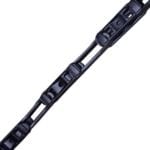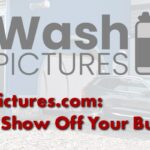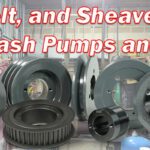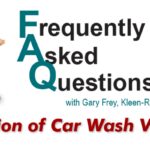Conveyor tunnels are generally one of the greatest revenue generators at high-volume car washes. Your conveyor is the means by which cars move through your wash, so it’s important to make sure that your chains and rollers are in perfect working condition. If one step of the wash process breaks down, customers can skip that step or have it replaced with manual work by an attendant. That’s not ideal, but it keeps business moving. But if your conveyor is broken down, your tunnel is out-of-commission. Car wash tunnel roller and chain maintenance is key!
Rollers and chain work together for the basic purpose of moving a vehicle from one end of your tunnel to the other. As your customer comes into to the tunnel, the motor-powered chain turns on, the vehicle drives over it, a roller raises up, and the roller catches the back wheel and pushes the car forward. Simple as that, right? Not quite!
How Conveyors Work
Chains work congruently together by using a pin and cotter to keep the links together. There are 16-link chains and 32-link chains. The pin and cotter gives the chain the ability to shortened or lengthened as needed. There always has to be a way to adjust the chain, because it stretches after running for an extended period of time.
Stretching causes the chain to jump off the gears and/or pop a roller, which in turn will keep the system from working. A car wash operator should always keep the chain at a proper tension. Tom Allen, Senior Technician at Kleen-Rite, says that most car washes have a tensioner that uses hydraulics or air cylinders to automatically tighten the chain when you turn on the system.
“If the chain is not tight, it will not operate correctly and will end up popping off drag gears,” Allen said. “And if that happens you could very well break a link and have a completely non-functioning chain.”
Keep an Eye on It!
Simply taking the time to closely watch your chain operating can help avoid costly breakdowns. On many chains such as X458 or C188, you can usually replace a link if needed. On some other chains, like certain D88K versions, you may have to replace an entire section if there is a problem with one link. Not sure what kind you have? You can look for the identifying number on the side of the chain.
Allen recommends that standard car washes servicing 75-100 cars a day should be checked at least once a month. If you have a high-volume wash that brings in 200-300 cars a day, then it should be checked daily.
“Nothing is worse than your whole system breaking down due to low maintenance and having to call up Kleen-Rite asking for extra rollers shipped next day air,” Allen said. “The time you use to replace your chains and rollers during peak business hours is costing you money, and that is not what you want as an operator.”
Taking Inventory
Automatic car wash operators should always have extra rollers, chain links, chain sections, and pins on their shelves. No matter what kind of chain you have, you must have spares of every part that can possibly break!
When ordering new chains, rollers, and other parts, be sure to know what kind of products you need in advance. By knowing the kind of chain in your system, the distributor can match it to the appropriate links and other products. Allen notes, “Kleen-Rite wants to know every detail to ensure customers get exactly the right products for their needs.”
Buying Conveyor Products
Browse all rollers, chains, sprockets, bearings, flanges, cotters, pins, and other conveyor parts at the lowest prices in the industry at Kleen-Rite!















